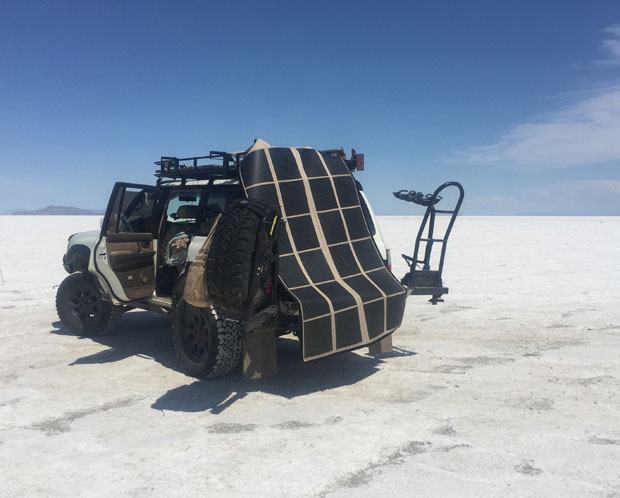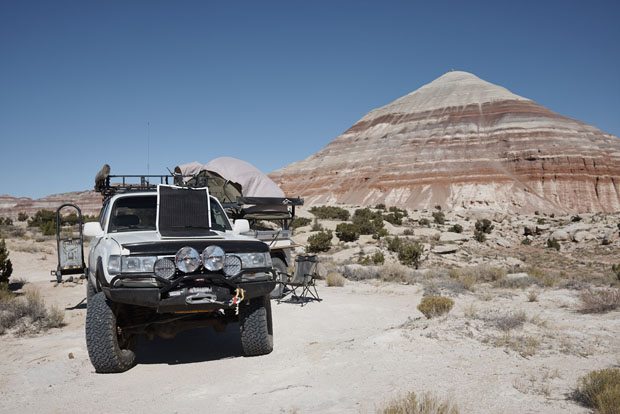Solar companies have their roots in sometimes very different industries. Like many products, solar panels have advanced significantly thanks to the military and its mission-driven need for power in the field. While consumer accessible solar has only emerged over the past decade, PowerFilm Solar marks 30 years in 2018 of developing today’s core solar technologies, as well as final products that incorporate those technologies.
That’s a remarkable length of time and dates back to PowerFilm Solar’s start within tech giant 3M. Dr. Frank Jeffery was working on thin film solar technology with fellow physicist Dr. Derrick Grimmer. The two scientists would ultimately steer their partnership with 3M and Iowa State University into what today is among the few producers of thin film solar products in the world. PowerFilm really took off when the U.S. Army awarded it a multi-million-dollar contract to help meet its need for field power sources, including both human-portable (foldable) products and solar tent structures.
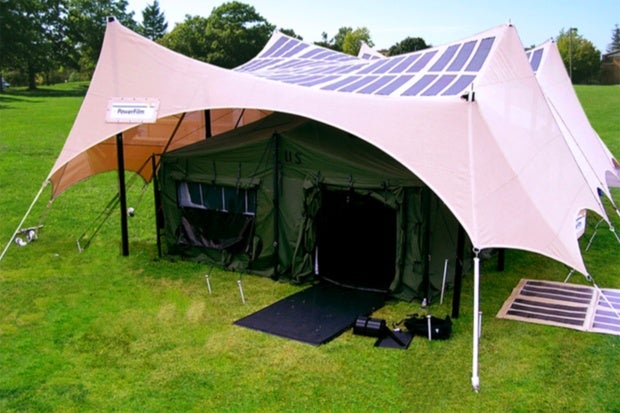
Today, PowerFilm, which remains based in Ames, Iowa, offers one of the most complete selections of thin film, military-grade solar units anywhere. But that alone doesn’t capture the spectrum of products coming out of the company. PowerFilm’s PowerDrive Golf Car Solar Panel, custom-designed solar cell applications and wide array of foldable and rollable solutions are American-designed, American-made and truly unique. With as much as half of their annual sales going to military contracts, their success is driven by mission-critical designs.
Read: Setting Up Your Overland and Off-Road Power System
To learn what PowerFilm Solar offers for those of us in off-road and overland communities, we approached the company for its product recommendations. The light, tough character of PowerFilm products is what attracts most consumers, coupled with the photovoltaic efficiency of the brand’s cells. Those features matter for explorers of the backcountry, adapting to the landscape they find themselves in and securing portable solar systems in a variety of ways. Renowned for their in-house lab testing, PowerFilm has built somewhat of a reputation for the extreme lengths its engineers have gone to with R&D. My favorite example is their real-time test of power loss as they peppered a panel with 9mm rounds.
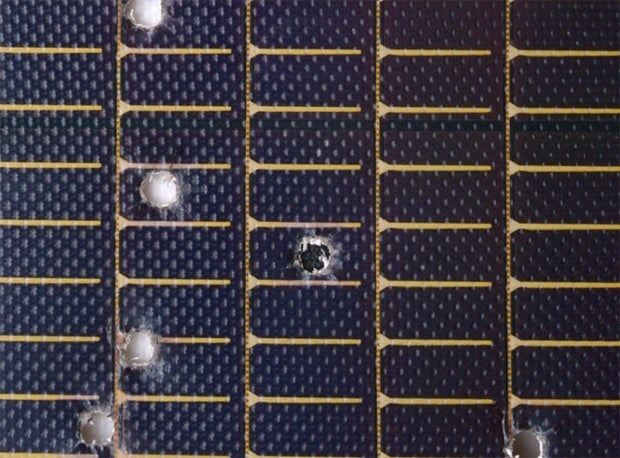
While punching holes through a panel for the sake of science sounds fun, our testing was focused on real-life loads you’d typically find in vehicle-based trips into the hinterlands. Packing, deployment, stowing and, of course, power production were the focus of our usage.
As I discuss in the Solar 101 and 201 articles, the key to an effective system is the proper pairing of components to your specific electrical demands. While PowerFilm makes enormous panels that are literally tents, their largest civilian model is rated at 220W. Seth Hansen, the company’s Marketing and Communications Manager, recommended some of the company’s most popular models for our needs, each having a distinct capacity. We agreed to test three of PowerFilm’s core products beginning in summer of 2017, and continued their usage through 2018. They included:
- 120 Watt Foldable PowerFilm Solar Panel
- 60 Watt Rollable Solar Panel
- LightSaver Portable Solar Charger
- SunSaver-10 PWM charge controller
- Nearly a dozen assorted cables and adapters
The largest, the folding 120W panel, provides 12V output in a compact, fabric-bonded poly-canvas base material. At less than 7 lb, it packs away easily and takes little more than a one foot by one foot stack of a few inches thick. In contrast, PowerFilm Solar offers the waterproof R60 as a rollable. Its compact tube shape fits around cylindrical objects like tent poles for packing efficiency, and is held fast by integrated straps. Deploying it is as simple as unfurling, and the weight is under 4 pounds. Smaller still is the innovative LightSaver. Serving as an all-in-one with battery included, the compact device targets those prioritizing weight and having modest power needs (e.g., phone charging).
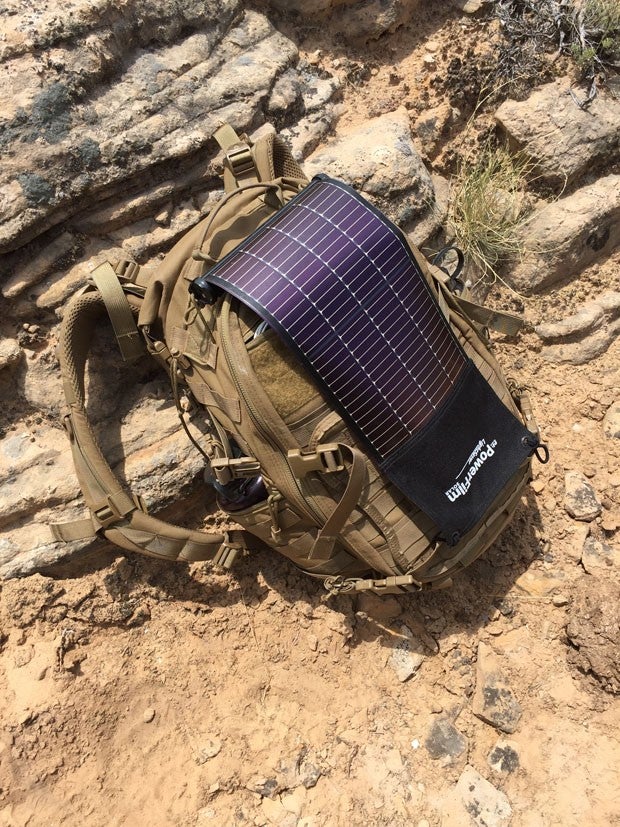
LightSaver
Living with these models reveals the benefits and compromises each offers. We’ve continuously used them to power a range of typical camp needs, as well as daily urban power demands. The PowerFilm Solar LightSaver is intended to keep pace with day-to-day depletion of handheld devices. As a result, we daily left it in the sun until its indicator light displayed solid green, confirming a full charge of its 3200 mAh battery. Once topped off, it reliably restored power to an iPhone 6 Plus that typically had only a quarter to a third of its capacity remaining.
Quick to roll out, and fairly easy to secure, thanks to its battery/charge cylinder and the two opposing end loops, the LightSaver could be left out to capture rays. During the heat of summer, some caution was needed to avoid overheating. This resulted not from the thin film but rather the battery/cylinder. Shading it from direct sun tended to resolve the overheat shut down problem, but requires some thoughtful placement/covering. With that done, we found the PowerFilm charge time estimates to be reasonably accurate.
Attaching your charge cable to the LightSaver is done thru a USB port, located on one end of the battery. On the opposite end is a charge indicator light (which only signals during active charging) and the micro USB A/C charge port. This makes for convenient access and visual monitoring; however, care must be taken to prevent dirt/sand and moisture from infiltrating the uncovered openings.
Users on the go will appreciate the freedoms the LightSaver provides. As its name implies, the design concept was a device that allowed solar uptake when the sun was out, and charging later. This is a distinct advantage over the many compact solar panels equipped only with charging ports, which require the device to be attached to turn rays into amps. For those with higher demands than the LightSaver can cover, PowerFilm has released the LightSaver Max, a substantially beefed up version with only moderate size/weight gains. While we did not have a chance to test it, the Max appears to be a meaningful addition to both the company’s product range, and to the overall market of portable solar devices.
60 Watt Rollable Solar Panel
Producing 12x the output of the LightSaver, the 60 Watt Rollable panel is meant to support a lot more than the recharging of a phone or GPS. Like each of the PowerFilm Solar products, its thin film technology performs well in indirect light and moderate shading, two situations that are the Achilles heel of most monocrystalline panels. This translates into a versatile, reliable source for power when conditions aren’t ideal, as well as when the sun is out in full force.
The characteristic that distinguishes the 60 Watt Rollable Solar Panel is its construction, which allows rolled storage. The tough vinyl backing material is stiff enough to help make its unfurled form lay flat, as well as resist lifting from light winds. It doesn’t retain a curl, and can be draped across a hood, windshield or log. Grommets allow it to be secured in windier conditions, cabled for security, or tied off to a rack so that it hangs vertically.
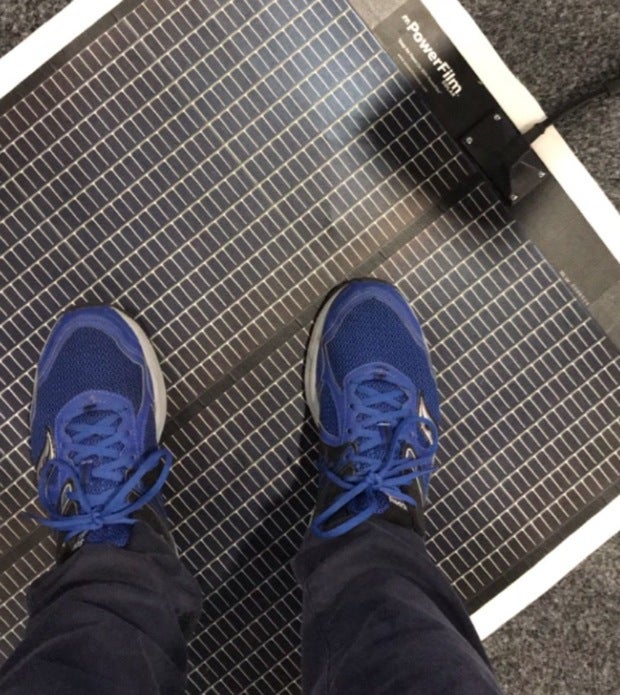
Deployed or rolled in seconds, the Powerfilm Solar 60 Watt Rollable places a premium on convenience when you want to catch some rays, or are ready to pack up. Its Velcro straps use top grade material, which in turn can be used to secure it from a bar or branch. Impervious to rain, you don’t have to use its speedy design just because a passing shower blows in. The trade-off, as with all rollable panels, comes in compactness. Although its material isn’t significantly thicker than a folding panel, the stiffness which makes setting it up a breeze also means you have a tube to fit in when packing. Again, this isn’t a big deal, so long as the user plans a storage cavity for it, assuring loads will not crush the ~4” diameter roll. Additionally, 60 Watt Rollable is more easily cleaned than foldables, as the smooth, seamless surface is simple to wipe off. This is a benefit in dusty conditions, as any mud or dust reduces solar absorption.
Despite the versatility its technology provides, the panel and its siblings in the rollable line still require consumers to be realistic when it comes to calculating needs. Attaining ~40W, on average, from these panels like others is a conservative safeguard that is both realistic and, on many days, apt to be exceeded in measured output. On the blindingly white glare of the West Desert and salt flats of the Utah/Nevada border, the lowest full sun outputs we recorded, in late summer heat, was right at 2/3 of the panel’s specified instantaneous output. Charge management was through the separate SunSaver PWM controller, which functions with either the 60 Watt Rollable or numerous other PowerFilm panels.
120 Watt Foldable Solar Panel
For medium electrical demand camps, the big 120 Watt Panel from PowerFilm Solar let us experience off-grid living with a military grade foldable array. Expanding impressively from its Velcro-secured stack, the folding system isn’t the type of finicky sequence of steps you think of with a road map. It is put away easily, and stows flat, the folds causing no resistance that would bulk up or make it less than flat.
We used the 120 Watt, as with the other PowerFilm Solar products, from the blistering heat of August on Utah’s Bonneville Salt Flats, to the state’s high northern mountains in mid-winter. As is typical with solar panels, cooler temperatures produced improved performance. A maximum output of 100 Watts was recorded in our testing across the 6 month window of seasons. In more extreme summer temp’s, despite clear skies, it was possible to see a 50% output of max rated wattage. In those situations, the surface was typically uncomfortably hot to the touch. These figures are a reminder of the climatic factors that impact all panels, and should be considered before estimating the needed wattage capacity.
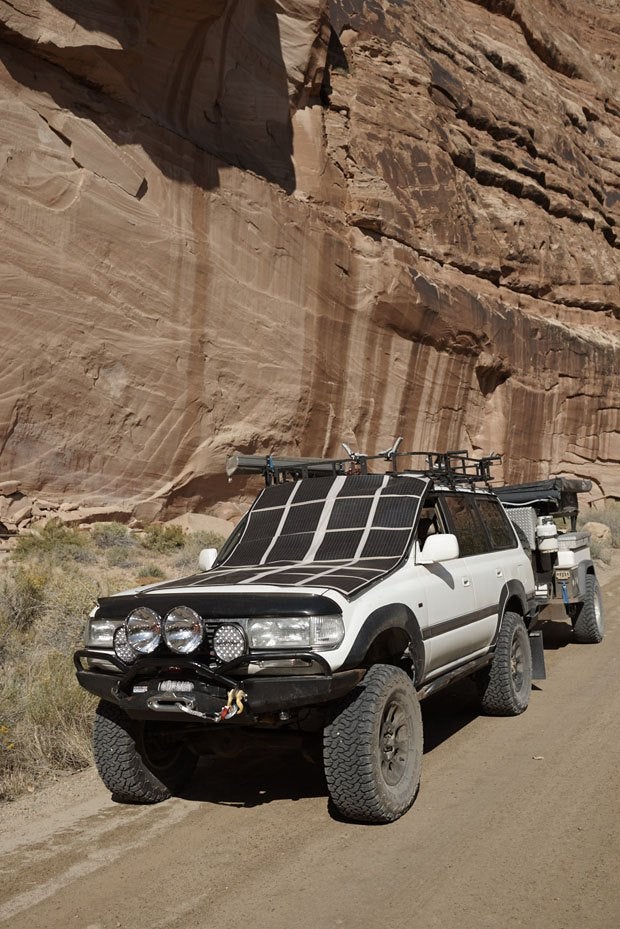
Despite its light weight, the 120 Watt feels substantial, due to the tough thin film substrate and the durable nylon backing. When folded up, the PV cells are fully protected by the backing, and the Velcro flap keeps the Delphi (heavier MilSpec) connector shielded from impact or dust. Like each of PowerFilm’s panels, cables and charge controller connections, the automotive industry Delphi/Weatherpack connectors used throughout offer locking, sealed single-clip attachment. Their locking tab is simple to work, preventing accidental detachment that SAE and other connectors are susceptible to. Their secure clip can require removing gloves to operate the clip when detaching cables, but this minor step is worth the sacrifice. It certainly beats discovering at sunset that some accidental bump disconnected a cable and prevented a day’s worth of charging.
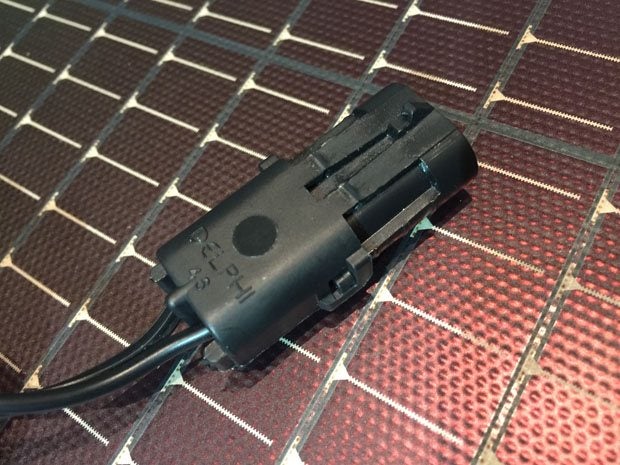
The weight and the pliable nature of the 120 Watt Foldable means it drapes well across many surfaces and structures. For ease of setup it’s hard to beat the convenience of Nite Ize Gear Ties, which fit the panel’s grommets and bear the panel’s weight even in light winds. I would suggest 3-6 in total, though I’ve used as few as two. These or a similar means for fastening is also helpful when the inevitable repositioning of the panel is needed to chase the Sun’s movements. When doing so, the size of the 12V panel becomes more evident. As with any such higher output panel, the process of repositioning is made easier with some forethought to how you secure and then rotate/pivot its orientation.
That effort to situate a large, pliable fabric panel, when compared to the ease of a rigid/flexible panel, is easily forgotten when it comes time to pack up. Foldable panels like this PowerFilm model stow and deploy in seconds, can fit into a daypack, will slide under a seat, and generally encourage you to grab some quick amps even when making a brief stop like lunch. That’s not surprising when you consider the demands on military troops whose very safety and mission is reliant upon speed and mobility. Each of the PowerFilm products we’ve used demonstrates that commitment to portability and toughness.
The Takeaway
With each of their panel types having distinct design intents, there is no “best” model from among the PowerFilm Solar products we tested. Even within the product lines they represent, these models represent specific wattage outputs, which need to be selected based upon your particular needs. Fortunately, with dozens of models available, from marine to RV, PowerFilm is a company with options to suit electrical demands from a short day hike to an expedition encampment. Coupled with appropriate battery storage, their panels offer Berry Amendment compliant solutions for all branches of service, and peace of mind for the rest of us whose adventures call for reliable off-grid solar.
About the Gear Doctor
Sean Michael has been designing, abusing and testing outdoor gear since the 1980’s. He began reviewing for Off-road.com in 2000, and today lives in the Northern Wasatch Mountains, where he is Director of the Outdoor Product Design & Development program at Utah State University. Follow his trips and gear at thegeardoctor on Instagram.
We are committed to finding, researching, and recommending the best products. We earn commissions from purchases you make using the retail links in our product reviews. Learn more about how this works.
